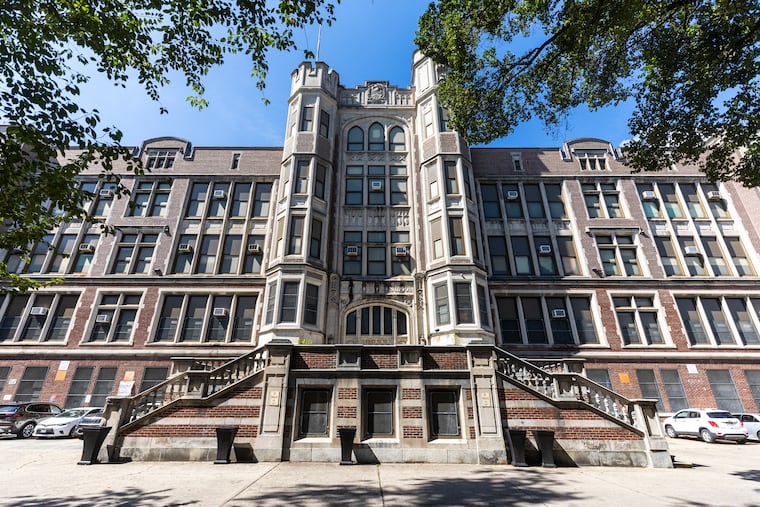Philadelphia’s schools have a plan to tackle building hazards. It’s not good enough.
The School District is wise to set up a plan for if school buildings become unsafe. But transferring kids to safer buildings at the last minute shouldn’t be the "new normal."

Last month, one of my second graders was agitated and upset. Like many children with autism, she thrives on consistency. When she saw that I got new stickers for her behavior chart and that her new sticker wasn’t the sparkly flower she was used to, she started to cry.
To calm her down, I showed her the empty sticker sheet, explaining that there were no more sparkly flower stickers and that it was time to open a new pack of the smiley-faced ones. She squeezed a stress ball and took deep breaths with me until she was ready to learn again.
Next time, I will warn her when the sticker pack gets low so she is prepared for this change. In my years as a special education teacher in Philadelphia’s public school system, I’ve learned that every tiny change can be a trigger for my students, and I have to be prepared.
Later that day, I got a notification about the School District’s “Swing Space” plan, which calls for specific schools to be ready at a moment’s notice to accept all students whose school buildings have closed because of a range of building hazards such as asbestos, water leaks, or lack of heat.
All I could think was, “If my students have a hard time changing stickers, how would they react to changing their whole school at the last minute?” Routine is especially important to students with disabilities, which is why I prepare them carefully for any type of change; a field trip, a teacher’s absence, or an assembly can all cause distress. I cannot imagine what it would be like for me to properly prepare my students with autism for changing schools at the last minute.
Unfortunately, the Swing Space plan is necessary. Already this school year, an elementary school in South Philadelphia closed because of asbestos, and a high school near Temple University’s campus was forced to relocate because of a broken heating system.
Last year, 74 schools closed early on the first day because of a lack of air-conditioning, and since March, seven schools have closed because of asbestos.
It is criminal how often the lack of funding and operational infrastructure compels us to close schools.
» READ MORE: My school is closed until 2024. It feels like we have been forgotten. | Opinion
While it is a bleak reality, it doesn’t have to be this way. Fully funding our schools, as was mandated in the recent school funding lawsuit, would provide Philadelphia’s schools with the resources to upgrade their infrastructure.
To some, fixing buildings may feel secondary to fixing test scores, but the issues are intertwined: safe buildings lead to healthier students and staff, which means better attendance. Safe schools also lead to the most basic need, which is schools staying open.
The School District of Philadelphia is one of the more than 80% of Pennsylvania districts that are underfunded. According to a recent analysis, we are underfunded by an estimated $7,926 per student. Just think about that.
To make matters more dire, the cost to fix Philadelphia’s school infrastructure could run in the billions, and the district is facing a $407 million deficit in the 2024-25 school year.
I do not blame the district for making a Swing Space plan; it is good to have a backup. However, transferring kids to safer buildings at the last minute shouldn’t be the “new normal,” especially for our most vulnerable students. The district should be investing an equal amount of resources into finding ways for them to flourish where they are.
The Basic Education Funding Commission, tasked with fixing our unconstitutional school funding system, must commit to closing the $6.2 billion adequacy shortfall over the next five years, and Gov. Josh Shapiro must include a $2 billion (the amount recommended by the lawyers representing underfunded districts in the trial) down payment in this year’s budget proposal. The state must also commit specific funding for facilities, with an investment of at least $400 million next year.
The state has starved Philadelphia’s schools and other underfunded districts across the state, forcing us to roll out an entire plan for when — not if — our schools close. This is not adequate, and it certainly is not fair.
This is not adequate, and it certainly is not fair.
The entire premise of the Swing Spaces plan has me wondering: How many properly funded schools have plans for if their schools end up being toxic? What do those students look like? How much money do their parents make?
Philadelphia’s students — especially those with special needs, such as autism — deserve better. All students in the commonwealth deserve a safe and routine place to learn, no matter their zip code.
Nicole Wyglendowski is a Teach Plus Pennsylvania senior policy fellow and a special education teacher in the School District of Philadelphia.